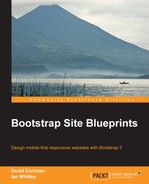Our utility-nav class runs into problems when the navbar collapses for small screens. The most immediate problem is that it disappears:

We can make our utility-nav class visible again by assigning it a z-index value greater than that of the navbar's, which is set to 1000 by a variable in _variables.less. In _banner.less, set the z-index property of .utility-nav to 1999.
.utility-nav {
...
z-index: 1999;This will bring our utility navigation back to the foreground as seen in the following screenshot:

Now the problem is that it overlaps our navbar-toggle button. We need to move the toggle to the left side of our navbar. This can be done as follows:
- Open
less/_navbar.lessin your editor. - Search for the comment
// Navbar toggle. We'll edit the lines within the.navbar-toggleselector immediately beneath this comment, changing thefloatvalue fromrighttoleftandmargin-righttomargin-left:.navbar-toggle { position: relative; float: left; // edited margin-left: @navbar-padding-horizontal; // edited
Save and compile these changes, and you'll see the navbar toggle shift to the left end of the collapsed navbar, as shown in the following screenshot:

So far so good.
Now to address the problem of crowding by hiding the text for all devices except for screen readers on the collapsed navbar. In an uncluttered collapsed navbar, the icons will be enough to communicate the point, especially if we make the icons larger. Let's do that:
- In
index.html, placespantags around the text within each link of ourutility-navclass as follows:<li><a href="#" title="Login or Register"><i class="icon fa fa-user fa-lg"></i> <span>Log In or Register</span></a></li> <li><a href="#" title="View Cart"><i class="icon fa fa-shopping-cart fa-lg"></i> <span>View Cart</span></a></li>
This will give us a handle for our upcoming style adjustment.
- Now, in
_banner.less, we'll add a media query to target thesespantags. Thanks to the power of LESS, we can nest the media query precisely where we want it to do its work. We'll use the@grid-float-breakpointvariable, setting amax-widthquery to the@grid-float-breakpointvalue minus one, since this variable determines the point at which our navbar makes the transition from collapsed to expanded. Within this media query, we'll use the utility classsr-onlyas a mixin to hide text from all devices except screen readers. (See the documentation on this class at http://getbootstrap.com/css/#helper-classes-screen-readers.) Here is the code snippet:.utility-nav { ... ... > a { ... @media (max-width: (@grid-float-breakpoint - 1)) { span { .sr-only(); } } } }This will hide the text between our
spantags, leaving us only with the icons! - Now, we will increase the size of the icons and add some line height to position them vertically. We'll do this within the same media query:
@media (max-width: @grid-float-breakpoint) { span { .sr-only(); } .icon { font-size: 2em; line-height: 1.2; } }
Save, compile, and refresh; you should see the following result:

Take a minute to resize your browser window back and forth across the breakpoint. You should see the entire banner and navbar adjust seamlessly across the breakpoint.
If you're like me, it's hard not to be pleased with a framework that enables us to be this efficient at building such an adept and responsive interface.
Next up, we need to begin implementing the color scheme.
